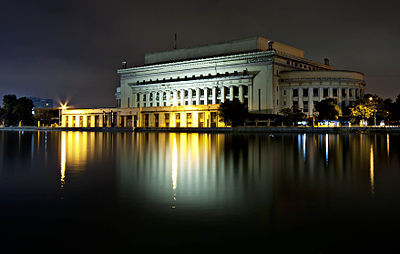
Search
Philippine Postal Corporation

The Philippine Postal Corporation (Filipino: Korporasyong Pangkoreo ng Pilipinas), abbreviated and stylized as PHLPost and also known as the Philippine Post Office, is a government-owned and controlled corporation responsible for providing postal services in the Philippines. The Philippine Postal Corporation has in excess of 8,000 employees and runs more than 1,355 post offices nationwide. It is based in the historic Manila Central Post Office, situated at the Liwasang Bonifacio and overlooking the Pasig River, and is currently headed by Postmaster General and CEO Luis D Carlos. Its policy-making body is the board of directors, headed by its chairman, Mr. Raul R. Bendigo. The board of directors is composed of seven members, including the postmaster general, who serves simultaneously as the chief executive officer.
Previously an attached agency of the Department of Transportation and Communications (DOTC) and the Commission on Information and Communication Technology (CICT), the Philippine Postal Corporation is under the direct jurisdiction of the Office of the President of the Philippines.
The Overseas Filipino Bank, previously the Philippine Postal Savings Bank, is one of three government-owned banks in the Philippines, it was formerly organized under PHLPost but is now a separate company.
History
The Philippine postal system has a history spanning over 250 years. In 1767, the first post office in the Philippines was established in the city of Manila, which was later organized under a new postal district of Spain. At first, the postal office served mainly to courier government and church documents. In 1779, the postal district encompassed Manila and the entire Philippine archipelago. The postal district was reestablished on December 5, 1837. A year later, Manila became known as a leading center of postal services within Asia. Spain joined the Universal Postal Union in 1875, which was announced in the Philippines two years later. By then post offices were set up not only in Manila but in many major towns and cities in the provinces. During that time, badageros or horseback-drawn letter carriers were dispatched to deliver mail from the "Tribunal" or town hall to "Casa Real" or the provincial capital.
It was during the Philippine Revolution that President Emilio Aguinaldo ordered the establishment of a Post Office to provide postal services to Filipinos. It was later organized as the Bureau of Posts under the Department of Trade on September 5, 1902, by virtue of Act No. 426, which was passed by the Philippine Commission. The Philippines eventually joined the Universal Postal Union, this time as a sovereign entity, on January 1, 1922.
The Manila Central Post Office building, the headquarters of the Bureau of Posts, was constructed in its present-day Neo-Classical style in 1926. It was designed by Filipino architect Juan M. Arellano and inaugurated in 1931, but was destroyed during World War II. After the war, the Central Post Office was rebuilt in 1946. It has since become a prominent landmark and tourist attraction in Manila.
On May 21, 2023, a massive fire hit the Manila Central Post Office late in the night and continued until the morning of May 23. The edifice was completely gutted, with Postmaster General Luis Carlos saying that "from the basement to the ground floor all the way up to the fifth floor; the structure was still there, but the ceiling had fallen down." He also said letters, parcels and the postal agency's entire stamp collection were likely destroyed, but clarified that only the mail service in Manila was affected by the fire. Fifteen people, mostly firefighters, were injured, while the amount of damage was estimated to be worth around ₱300 million.
In the aftermath of the fire, the Philippine Postal Corporation said it was transferring the central office's operations to the Foreign Surface Mail Distribution Center in Port Area, Manila, while the business mails service for private corporations was to be moved to the Central Mail Exchange Center in Pasay, near Ninoy Aquino International Airport.
See also
- Commission on Information and Communications Technology
- List of postal codes in the Philippines
- Postal addresses in the Philippines
- Postage stamps and postal history of the Philippines
References
External links
- Official website
- Members Countries of Universal Postal Union
Text submitted to CC-BY-SA license. Source: Philippine Postal Corporation by Wikipedia (Historical)
Articles connexes
- ZIP codes in the Philippines
- List of postal entities
- PhilPost Postal ID
- Postal addresses in the Philippines
- Manila Central Post Office
- Government-owned and controlled corporation
- List of government-issued identity documents of the Philippines
- Postage stamps and postal history of the Philippines
- Philippine national identity card
- Overseas Filipino Bank
- Paeng Nepomuceno
- Monique Lhuillier
- Eraño Manalo
- Cabinet of the Philippines
- Gloria Romero (actress)
- María Orosa
- List of Philippine government and military acronyms
- Cities of the Philippines
- Office of the President of the Philippines
- Panday (character)
Owlapps.net - since 2012 - Les chouettes applications du hibou



